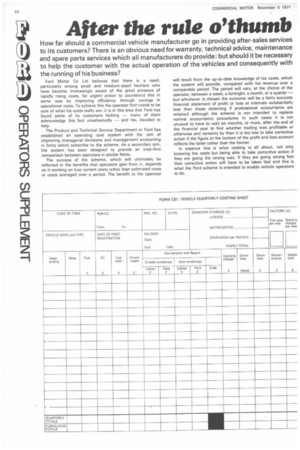After the rule &thumb
Page 72

Page 73

If you've noticed an error in this article please click here to report it so we can fix it.
comes the reckoning
Ford Motor Co Ltd believes that there is a need, particularly among small and medium-sized hauliers who have become increasingly aware of the great pressure of rapidly rising costs, for urgent action to counteract this in some way by improving efficiency through savings in operational costs. To achieve this the operator first needs to be sure of what his costs really are; it is in this area that Ford has found some of its customers lacking — many of them acknowledge this fact unashamedly — and hat; decided to help.
The Product and Technical Service Department at Ford has established an operating cost system with the aim of improving managerial decisions and management accounting in firms which subscribe to the scheme. As a secondary aim, the system has been designed to provide an inter-firm comparison between operators in similar fields.
The success of the scheme, which will ultimately be reflected in the benefits that operators gain from it, depends on it working on true current costs rather than estimated costs or costs averaged over a period. The benefit to the operator will result from the up-to-date knowledge of his costs, which the system will provide, compared with his revenue over a comparable period. The period will vary, at the choice of the operator, between a week, a fortnight, a month, or a quarter—but whichever is chosen the outcome will be a fairly accurate financial statement of profit or loss at intervals substantially less than those obtaining if professional accountants are retained although the scheme is not intended to replace normal accountancy procedures. In such cases it is not unusual to have to wait six months, or more, after the end of the financial year to find whether trading was profitable or otherwise and certainly by then it is too late to take corrective action if the figure at the bottom of the profit and loss account reflects the latter rather than the former.
In essence this is what costing is all about, not only knowing the costs but being able to take corrective action if they are going the wrong way. If they are going wrong fast then corrective action will have to be taken fast and this is what the Ford scheme is intended to enable vehicle operators to do. The scheme — to give it its full title the Ford Commercial Vehicle Operating Cost System — is at present being operated on a pilot basis and has only been in use by the guinea pig operators, 166 of them running some 700 vehicles, for a short period. In fact the first quarterly return to Ford for the inter-firm comparison analysis was due in October and the results of this are not yet known.
In assessing the worth to an operator of such a scheme — or from Ford's point of view in selling the scheme to operators — it is necessary to consider how much work, or rather extra work, he will be required to do and for what return.
The work involved is not excessive and would appear to be far outweighed by the benefits. Ford supplies the documentation; explains the system, and provides an instructional pamphlet: helps the operator who has problems setting up the scheme; keeps a watch on progress; analyses the inter-firm return and reports the results of this to the operator. The operator begins with the biggest and mast difficult task; the one which often in the end is the most illuminating to him, namely calculating his overhead costs. He then reverts to the relatively simple but regular task of recording operating costs. Having once established his overhead costs the operator will not find it difficult to regularly update them as inflation takes its effect and, having established a routine, the operating costs can easily be recorded either on a weekly basis or less frequently if preferred. Four basic benefits may be shown as the return for the operator's effort.
First, he will have a cost recording system which he either did not have before or which offers something not accruing from his present system.
Secondly, he will have, by means of the inter-firm comparison, a relatively exclusive means of measuring his efficiency against that of "like" firms. This is something which is not generally available from any other source.
Thirdly, the system will automatically highlight high cost items which either need careful watching to ensure that they do not exceed economical limits or which may demand some immediate retaliatory action.
The fourth benefit is one which will help the operator with that most thorny of all transport decisions, vehicle replacement. From the cost system he will be able to establish an optimum vehicle replacement programme.
One vital document, the Vehicle Quarterly Costing Sheet (CS1), forms the nub of the whole system and this is backed up by three others which, when completed, contribute information for the CS1. These three forms are: Overheads for Year ICS2): Vehicle Weekly Record (CS3): and Vehicle Maintenance Record (C541.
The CS2 details all the items forming the overheads for the transport operation on a yearly basis and once completed — unless increases in these items dictate otherwise — these costs will act as a reference for a year.




































































































































































